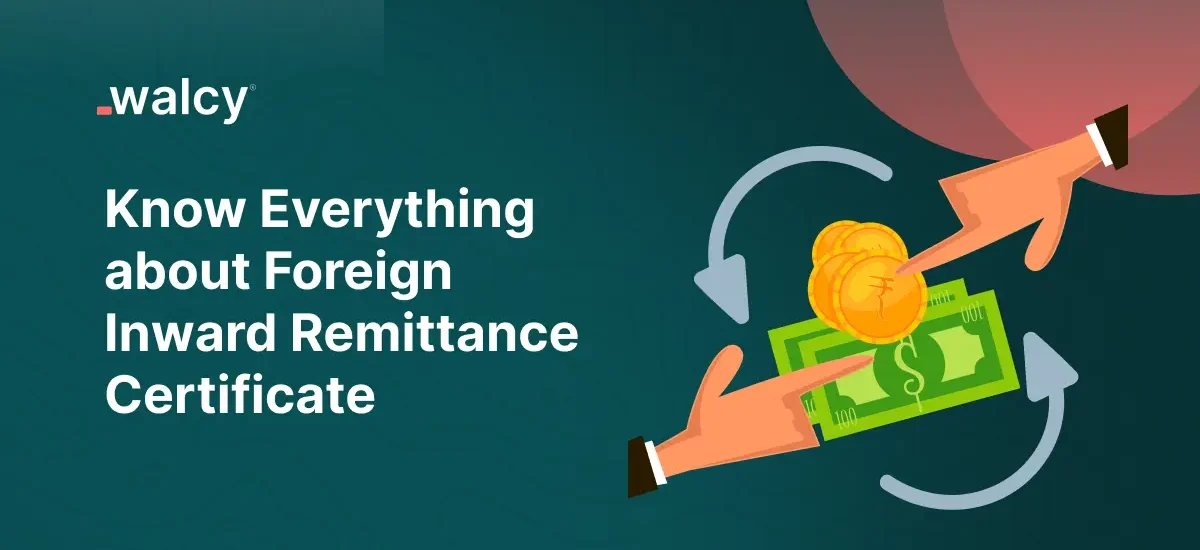One can note the cross-border transactions that flow into the country. In such a case, to the person remitting money to India from abroad, a Foreign Inward Remittance Certificate becomes very crucial in the purview of legal and financial processes. It is an all-inclusive guide regarding FIRC, covering its purpose, how to get one, the charges around it, and its importance in the banking sector.
What is a Foreign Inward Remittance Certificate?
A FIRC is a Certificate, issued to provide evidence of money being received from a foreign source into the country by India’s banks when remitted from abroad. It is a certificate issued by the bank in India where any money transfer gets affected, for instance, when someone receives money from any foreign source. The certificate is not only important for regulatory needs but also for tax purposes and for proving various financial transactions.
The foreign inward remittance document is an important document for businesses and even individuals who receive foreign funds in situations such as export payments, foreign investments, or even just donations. It acts as proof to the RBI or other regulators that the remittance is genuine and monies have come into the Indian financial system through proper channels.
Read about: The best way to transfer money internationally from India
Role of Foreign Inward Remittance Certificate in Banking
It is important for banks because FIRC is proof required to be furnished by banks to different government authorities in support of foreign remittances. An FIRC in banking is a basic document showing proper accounting concerning all incoming foreign remittances and proving their harmony with RBI norms. This certificate is issued by banks after receiving the foreign remittance and crediting it to the beneficiary’s account.
A foreign inward remittance certificate will be issued only after banks have verified the source and purpose of foreign remittance. This guarantees that the money is genuine and that the transaction has complied with every stipulation under the act. this document is crucial for businesses involved in international trade because it helps them claim tax benefits and fulfill regulatory requirements.
Read about: Bank Remittance In 2024 | How It Differs To Bank Transfer?
How to Obtain a Foreign Inward Remittance Certificate from a Bank
Getting an FIRC from a bank, of course, is not an altogether tedious task, but it certainly expects a few steps to be taken by the remittance beneficiary. Here’s how you can get it:
Initiation of Remittance:
How it’s done by an overseas entity or person who sends funds to a person in India. Funds are transmitted through wire transfers, international money transfer mechanisms, or even online portals.
Receiving the Funds:
The overseas remittance reaches the recipient’s bank in India and is credited to his or her account. Details of the remittance—sender’s information, purpose of transfer, and currency involved—are also noted by the bank.
Application for FIRC:
The payee must apply to the bank to provide the FIRC once the money is realized. This is usually made through a formal letter of request to the bank and providing it with information such as the transaction reference number and purpose of the remittance.
Verification and Issuance:
The bank will verify the remittance details and ensure that the transaction complies with all regulatory provisions. Once the above verifications are completed, the bank will issue the certificate of inward remittance. This will mention the amount received by the applicant in rupees, the foreign currency involved, the date of the transaction, and the purpose of remittance.
Receiving the FIRC:
The FIRC would be sent to the recipient via physical form or electronic form depending on the policy followed by the bank. Specific banks send out the FIRC against the payment of a fee. The fee depends upon the bank and the nature and amount of the remittance.
Foreign Inward Remittance Certificate: Importance for Business
For businesses involved in overseas trading, this certificate of inward remittance may grow crucial. It will establish the fact that a business has been paid for its products or services exported, and such is usual proof required by many a legal or financial procedure. The following are the major reasons why FIRC becomes important for businesses:
Claiming Tax Benefits: All businesses exporting goods or services can claim exemption from or can claim benefits on taxes paid under various government schemes. Foreign inward remittance certificate is often asked to prove that the payment was received from a foreign source, allowing the business to claim these benefits.
Regulatory Compliance: The RBI and other regulatory bodies in India mandate that companies keep detailed documentation of all foreign remittances. The FIRC will serve as a statutory document to ascertain that the company has abided by the rules and regulations applicable to carrying out a foreign exchange of money, ensuring the legal and lawful nature of the transaction.
Audit and Accounting: Businesses experience financial audits and have to provide evidence of recording all the transactions, even those of foreign remittances, to their auditors. They have to provide an FIRC to the auditors to have the financial statement recorded properly.
Legal Evidence: FIRC can be used as evidence in case disputes are finally settled at law courts, commercial dispute resolution mechanisms, and other laws showing that the business has discharged its liability under the contract for services or products provided through receiving payment from the foreign buyer. This, therefore, can be an important aspect while settling disputes that are surrounding payment terms and conditions.
Investment Compliance: When foreign investment comes into the business for proper documentation such as inflow of money an FIRC is made to bring in transparency and adhere to the Foreign Exchange Management Act (FEMA) rules and regulations.
Foreign Inward Remittance Certificate charges
Although obtaining an FIRC is generally not a problem, it needs to be kept in mind that there could be a cost involved for the same. In other words, the charges for the FIRC apply for that and may vary from one bank to the other, the type of the transaction, and the amount of the remittance. Here’s what you need to know about FIRC-related fees:
Issuance Fee: This is the fee charged by a bank to issue an FIRC. The fee can be flat or based on a certain percentage of the remitted sum of money into the country. It is always good to check for the charges with the bank earlier on.
Processing Fee: In addition to the issuance fee, some banks may charge a processing fee on the remittance transaction. The charge is basically to cover the administration cost of authenticating the transaction in the issuance of the FIRC.
Currency Conversion Fee: If a remittance requires that foreign currency be converted to Indian rupees, the bank involved may charge a currency conversion fee. This is usually an extremely small percentage of whatever amount is converted.
Courier Charges: If a FIRC is issued in physical form and is to be couriered, charges might be applicable for the courier service.
Other Charges: Some banks also provide other services like quick processing or online issuance of FIRC, and these are charged over and above the remittance charges. If you are a person who requires these services, check the prices of the same with your banker.
The charges do vary from one bank to the other bank. Therefore, just take some time to compare the prices of various bankers for initiating the remittance. Also, negotiating on the rates with the banker, especially on the fees, while doing a large transaction, is always beneficial.
Learn more about: fees associated with the international payments
What is in the FIRC Document?
The FIRC document is a detailed document containing all information relating to remittance arriving from abroad. For regulatory compliance and other purposes, it is important to know what its components are. Here is what a typical FIRC document will contain:
- Recipient Information:
The FIRC will carry the name and account information of the recipient announcing that the money has been credited to the right account.
- Senders Information:
Information about the foreign entity or individual who had sent the money, such as its name and bank account information, is provided.
- Remittance Detail:
The section contains information on the amount received, the foreign currency involved, and the rate of exchange used in converting the foreign currency into Indian Rupees.
- Purpose of Remittance:
The FIRC states the purpose for which the remittance has been made: payment for goods or services, investment, donation, or others.
- Date of Transaction:
The FIRC states the date on which the remittances have been credited to the account of the recipient.
- Bank’s Authentication:
The FIRC is authenticated by the issuing bank regarding its seal and authorized signatory’s signature, ensuring that it is a valid document.
- Reference Number:
FIRC holds a unique reference number that is related to the transaction that can be looked up or verified with ease.
Alternative of Foreign Inward Remittance Certificate
While FIRC is the document widely used for the certification of remittances from abroad, its alternatives can be used on some special or particular occasions. One substitute that exists is the Bank Realization Certificate (BRC). It is issued after the dues have been realized on the export proceeds. This type of certificate is generally used in export-related transactions and most circumstances serve a similar motive as the FIRC.
However, the BRC pertains to only export transactions, but the FIRC can relate to all kinds of foreign exchange remittances. Depending on the nature of the transaction as well as the requirements of the regulatory authorities, it is necessary to obtain either a FIRC or a BRC.
Common Issues and Solutions
Even with the easy process of getting an FIRC, a few common problems arise while receiving them. Below are some of the problems and how you can solve them.
Issuance Delay: Sometimes, it takes much longer than it should to issue an FIRC. In case of a delay, stay in touch with your bank, and be sure to get all the necessary documents to them.
The FIRC contains incorrect information: In such a situation, one must get in touch with the bank at the earliest to get the mistake corrected by providing all the corrected information. This helps in the quick issuance of another FIRC.
FIRC Lost: If you happen to lose your FIRC, you may request a duplicate from the issuing bank. Get ready with the transaction reference number, along with the other details, so that they can take the processing ahead.
Bank’s Non-issuance: The bank sometimes does not issue an FIRC because the remittance is opposed to the rules and regulations of the bank. In this case, also, it should be asked for clarification from the bank so that all the rules for repatriation of foreign exchange can be abided about.
Conclusion
FIRC, which means Foreign Inward Remittance Certificate, is one of the most important documents when funds are transferred into the country for an individual or business. This certifies that a person has received money through foreign remittance, with further compliance of different taxes and other issues according to the law. Knowledge about how to obtain a FIRC, the charges normally charged, and the importance of banking is very helpful in handling cross-border funds.
Whether a business that receives payments for exports or an individual who gets funds from family abroad, it is important to get a FIRC from your bank. Being aware of the process and not leaving any loose ends ensures that all your international remittances are properly documented and you will be able to flow smoothly with all the related laws of the land.
Learn about: Outlining The Latest Cross-Border Payment Trends
Do follow us on Facebook and LinkedIn, to stay connected with us.



